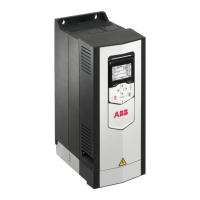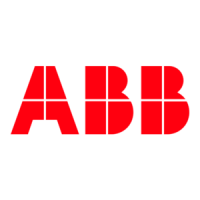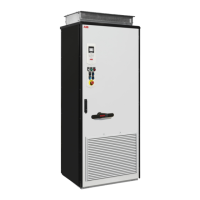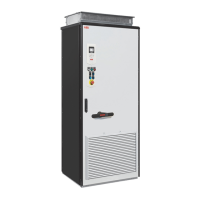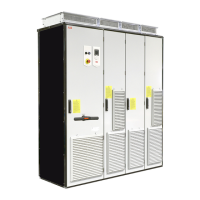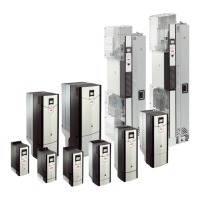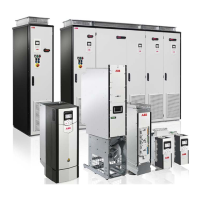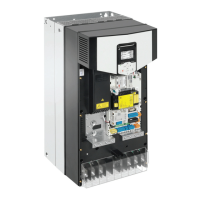Do you have a question about the ABB ACS880-01-145A-3+N5350 and is the answer not in the manual?
Instructions on how to contact ABB for technical assistance, including information needed for troubleshooting.
Contains essential safety instructions for installation, operation, and servicing of the drive to prevent injury or damage.
Details electrical safety warnings and precautions for qualified electricians during installation and maintenance.
Provides general safety instructions for handling the unit, managing hot surfaces, and preventing damage from debris.
Outlines safety guidelines for the initial start-up and ongoing operation of the drive and connected equipment.
Introduces the ACS880+N5350 drive, its design for cooling tower fans, and key features for variable speed control.
Lists the various international and industry standards that the ACS880+N5350 drives have been designed and tested to comply with.
Specifies the compatible motors for the ACS880+N5350 drive and advises contacting ABB for other motor types.
Describes the drive's enclosure ratings (UL Type 1, IP21) and environmental/mounting requirements for safe operation.
Details the segmentation of drive connections into Power and Control groups, emphasizing separation for noise reduction.
Explains the information provided on the type designation label, which identifies the unit's specifications and serial number.
Provides a detailed key for understanding the various codes and selections within the drive's type designation.
Presents electrical ratings for the standard ACS880+N5350 models, including catalog numbers, frame sizes, and output ratings.
Provides data on air flow, heat dissipation, and noise levels for various drive models, essential for installation planning.
Details the recommended copper cable wire gauge ranges for power connections based on catalog number and frame size.
Specifies the required tightening torques for power terminals (L1, L2, L3, T1/U, T2/V, T3/W, R-, R+/UDC+, UDC) by frame size.
Provides specifications for control wire sizes (0.5-2.5mm²) and tightening torques (0.5 N·m) for stranded and solid wiring.
Emphasizes the importance of proper grounding for safety and performance, detailing grounding conductor requirements.
Lists the designed incoming power ratings for the ACS880+N5350 and notes requirements for network type and frequency.
Explains the necessity of using fuses for short-circuit protection of the drive and input power cable.
Provides tables to guide the selection of appropriate wire gauges and input fuses based on control rating and current.
Details the wiring requirements for connecting the motor to the drive, including ground wire and safety precautions.
Discusses how drive output pulses can stress motor insulation and erode bearings, and mentions optional protective filters.
Explains the connection and function of motor thermostats for overtemperature sensing, using terminals XD24-1 and XD24-2.
Describes the 9 available digital inputs for controlling the cooling tower fan, their connections, and jumper settings.
Details the standard analog input for controlling fan speed, including voltage/current signal capabilities and potentiometer connection.
Provides technical data and jumper settings for Analog Input 1, used for speed reference and other analog signals.
Explains the use of three Form-C relay outputs for reporting internal drive states like faults or warnings.
Describes the two analog outputs (AO1, AO2) used for indicating signals like motor speed and torque to external systems.
Guidance on selecting power cables based on local regulations and the drive's nominal current rating.
References table for losses and cooling airflow, and specifies the allowed operating temperature range for the drive.
Advises on protecting the drive and input cable, referencing Table 5-2 for fuse operating times (below 0.5 seconds).
Details insulation resistance checks for input/motor cables and the motor, specifying test voltages and minimum resistance.
Step-by-step instructions for connecting power cables, including cover removal, conduit fastening, and terminal connections.
Instructions for connecting control cables, including conduit fastening, shield grounding, and conductor termination.
Illustrates the default I/O connections for the ACS880+N5350 in the 2-wire primary control program.
Provides a checklist for UL compliance, covering environmental conditions, circuit protection, and cable requirements.
Guides on installing and performing the initial start-up of the Assistant control panel for the drive.
Describes the display, keys, and main components of the Assistant control panel for efficient operation.
Explains how to switch between keypad control (Local) and terminal strip or network communications (Remote).
Covers fundamental operations, user interface components, common tasks, and navigation instructions for the drive.
Provides a list of common user tasks and instructions on how to complete them, such as parameter management and basic drive operation.
Details the 2-Wire Operating Mode, used for simple stop/run control with a single selector switch.
Explains the 3-Wire Operating Mode, utilizing momentary start and stop pushbuttons for fan control.
Describes the Process Control (PID) mode, which offers auxiliary closed-loop set point control for various configurations.
Covers operating the drive via an optional fieldbus adapter or the embedded fieldbus port for external control.
Provides configuration steps for using fieldbus adapter modules to control and monitor the drive.
Details the setup for controlling the drive via the embedded fieldbus port (D2D port) using Modbus RTU protocol.
Explains the trickle current heating feature, used to maintain motor windings and prevent condensation during standby.
Describes the critical speed function for avoiding mechanical resonances by prohibiting operation in specific frequency bands.
Details the De-Ice function, which runs the tower at low speed in reverse to prevent ice buildup in cold climates.
Covers advanced drive functions such as PID control and Fieldbus control, including access levels and passcodes.
Explains the different access levels (CTDD User, Fieldbus, Expert Commissioner) based on passcode parameters.
Provides a wiring diagram example for the 2-Wire Operating Mode using a manual motor disconnect switch.
Illustrates a wiring diagram example for the 3-Wire Operating Mode with a manual motor disconnect switch.
Presents example configurations for manual motor disconnect or power-off fail-safe shorting contactors.
Describes the basic start-up assistants for motor data, ID run, and setting up the ACS880 drive with the +N5350 program.
Guides through the initial motor data setup and ID run process, including safety and language selection steps.
Details the Drive Assistant (CTDD Setup) for configuring the cooling tower application after motor data start-up.
Explains how warnings and faults are annunciated, their behavior (latching, reset), and how to identify them.
Covers accessing and interpreting the event log, auxiliary codes, and parameters containing warning/fault information.
Lists common warning messages alphabetically, including their fault number, cause, and recommended actions to resolve them.
Provides a comprehensive list of fault messages, their fault numbers, causes, and corresponding troubleshooting steps.
Presents detailed technical specifications for the ACS880+N5350 drive, covering electrical, motor, and connection data.
Provides dimensional data, weights, and required free space for different frame sizes (R1-R9) for installation.
Lists the applicable European standards for CE compliance, including Low Voltage, EMC, RoHS, and Machinery Directives.
Explains the meaning of the CE mark and its verification of compliance with European directives and safety functions.
Details compliance requirements for EMC standards, including definitions for Categories C2, C3, and C4.
Provides definitions for key EMC terms like Electromagnetic Compatibility and environments for drive usage.
Outlines provisions for Category C2 drives, including EMC filter usage, cable selection, and installation requirements.
Specifies provisions for Category C3 drives, requiring specific EMC filters and adherence to cable length limitations.
Details conditions and provisions for Category C4 compliance, focusing on minimizing emissions to neighboring networks.
Lists the UL Type 1 and UL Type 12 drives and their applicable voltage ranges and frame sizes.
Provides a checklist for UL compliant installations, covering environment, temperature, circuit protection, and cable ratings.
States that the drive has been given a GOST R certificate of conformity.
Manufacturer's disclaimer regarding obligations for products that have been improperly repaired, misused, or altered.
Safety warning regarding lifting heavy drives (R6-R9) using designated lifting eyes to prevent injury.
Requirements for the installation site, ensuring proper ventilation, wall suitability, and adequate free space for operation and maintenance.
Lists essential tools required for installation, including drills, screwdrivers, and wrenches.
Instructions for moving the drive's transport package to the installation site using a pallet truck.
Illustrates the transport package contents for frames R1-R5 and outlines the unpacking procedure.
Shows the transport package contents for frames R6-R9 and details the unpacking steps, including hoist usage.
Provides instructions for installing the drive, including marking, drilling, and securing mounting holes for various frame types.
Refers to a separate supplement for instructions on cabinet installation of the ACS880-01 drive.
Overview of the ACS880 Cooling Tower Drive setup for monitoring and control via Modbus TCP.
Step-by-step guide for setting up Modbus TCP communication, including parameter configuration and simulation.
Introduction to setting up the ACS880 Cooling Tower Drive for monitoring and control via Modbus RTU.
Detailed guide for setting up Modbus RTU serial communication via the D2D port, including parameter configuration.
Overview of setting up the ACS880 Cooling Tower Drive for monitoring and control over Ethernet/IP.
Step-by-step instructions for configuring Ethernet/IP communication, including parameter settings and PLC integration.
| Rated Current | 145 A |
|---|---|
| Cooling Method | Air Cooled |
| Enclosure | IP21 |
| Communication Interface | Ethernet |
| Input Voltage | 380-480V AC |

